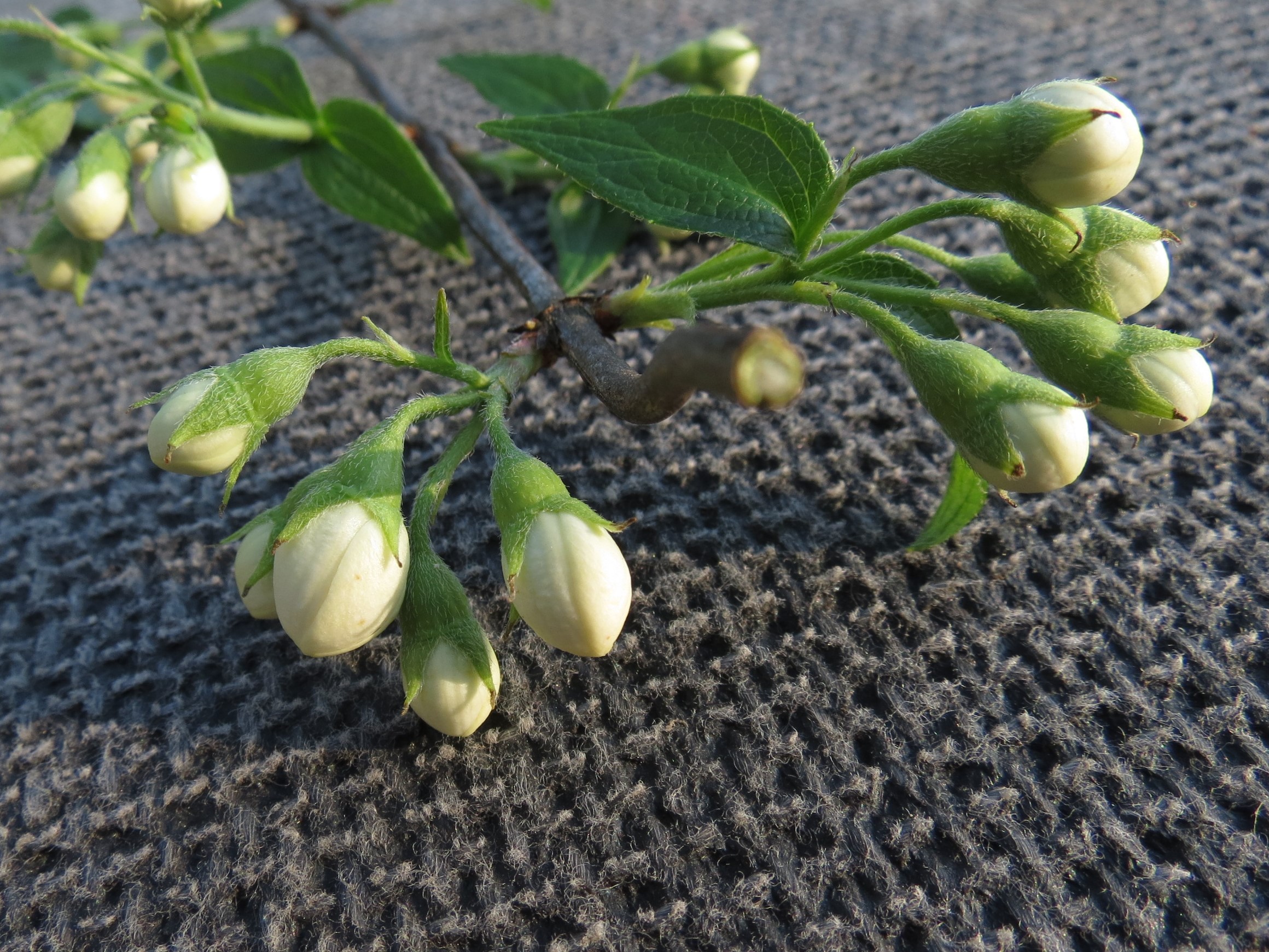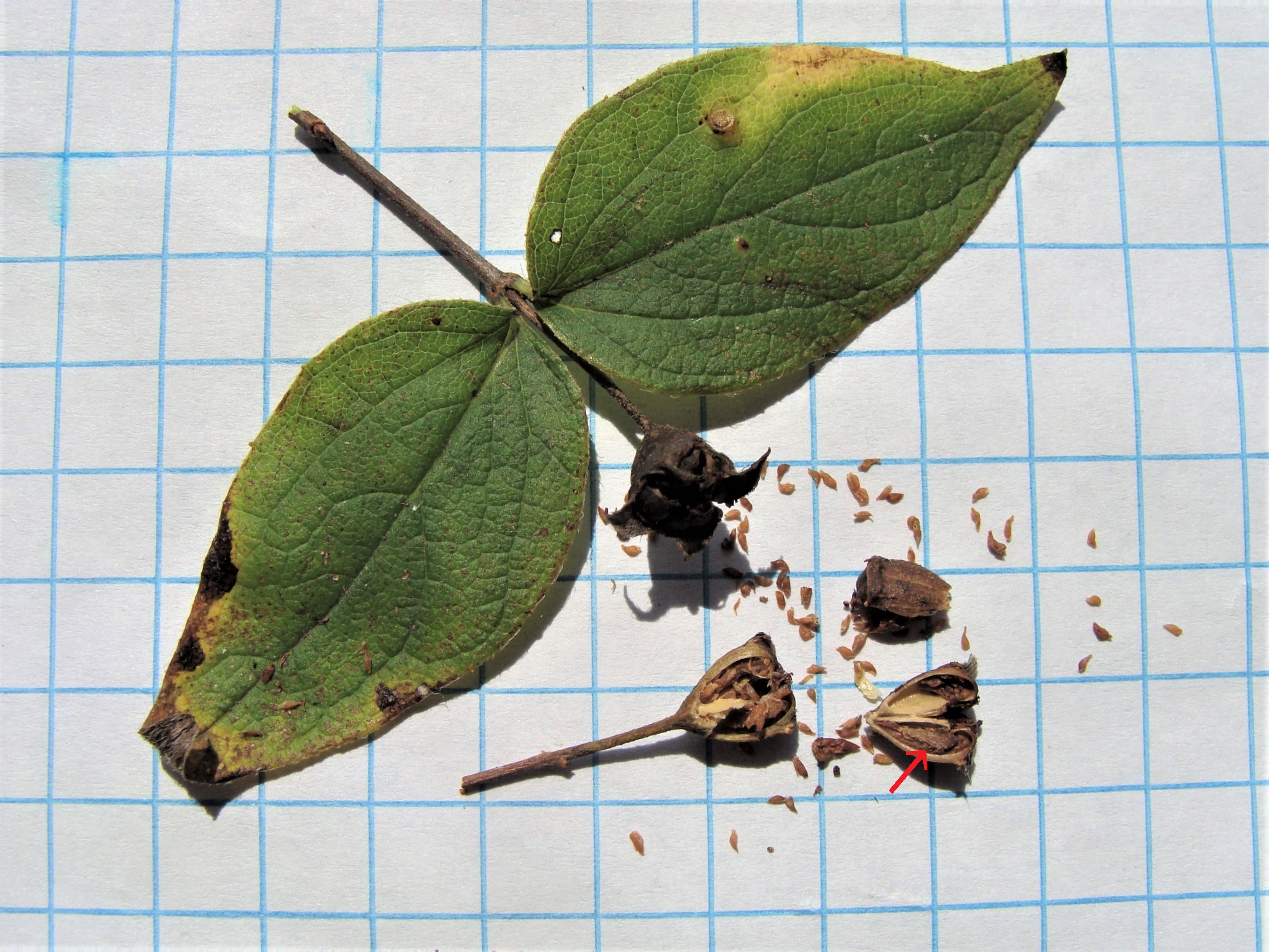Hairy Mock Orange (Philadelphus hirsutus) of the Hydrangea (Hydrangeaceae) family, formerly of the Saxifrage (Saxifragaceae) family, is a deciduous shrub with rather large, showy, four-petaled white flowers. The genus name is said to honor Ptolemy II Philadelphus, pharaoh of Egypt (283-246 BC). The specific epithet is Latin for “hairy.” The common name “Mock Orange” refers to the flowers being somewhat similar to those of the true orange (Citrus sinensis). In the U.S., along with a disjunct distribution centered in north-central Arkansas, the species is found principally in an area centered on the Southern Appalachians. In Arkansas, it occurs primarily in the Boston Mountains and Arkansas Valley, with a few south-central Ozark Highlands occurrences. Habitats include dry to mesic rocky outcrops, ledges, talus slopes, and seepage areas, on various rock types, on open or wooded sites. It is also known as Cliff Mock Orange.
The shrub has a few to numerous, erect to spreading stems that become arching in age. A few clonal plants, growing from shallow root extensions, may appear a foot or more from the base of the parent plant. Beginning in the second growth year, the bark exfoliates in thin strips. Although typically under six feet tall, stems may reach ten feet in ideal habitats. Shrubs tend to be somewhat taller than broad and may have only a few large stems or large stems intermixed with root shoots, growing from a compact clump.
Pointed terminal and lateral buds are covered with tight overlapping brown scales. Terminal buds produce a leafy branch which may end with a pair of opposite leaves or a floral cluster. Lateral buds produce either a sterile leafy branch or a short floral branch, with or without a subtending pair of leaves. Since floral clusters are terminal, the next year’s growth of floral stems occurs from lateral buds. New, rapidly growing, robust branches sprout along arching mature stems or directly from the rootstock. Mature shrubs tend to be open with most active growth and flowering at the perimeter.
New branches and twigs are pale green with appressed, dense, soft pubescence, becoming brown to reddish brown and glabrous within several months. With springtime growth, the brown bud scales persist. Additionally, several elongate, leaflike bracts occur near the base of new branch growth. Pubescence of new twigs extends onto the leaves and inflorescences. Stem pith is white.



Simple, opposite, petiolate leaves vary from lanceolate with an acuminate apex (smaller leaves) to ovate-elliptic with an acute apex (larger leaves). A larger leaf may be 3¾ inches long, including a ¼ inch petiole, and 1¾ inches wide. Leaf bases are acuminate to nearly rounded. Leaf margins, mostly in the distal half, have a few widely spaced, blunt or sharp teeth. Venation is pinnate, the secondary veins arching toward the leaf apex, with the lowermost pair most prominent. Dense appressed pubescence covers the entire lower blade surface and extends along the lower side of the petiole. The upper surface can feel a bit rough, with shorter, sparser pubescence. Leaves are somewhat leathery (coriaceous).




The inflorescence is borne on new-growth branches in late April into May. Terminal and axillary, perfect (with male and female parts) flowers occur singly or in clusters of 2-5. They are about ¾ inch long and wide, with an obconic round-topped inferior ovary, a calyx of 4 triangular sepals, a corolla of 4 white petals, 20± stamens (along with a few staminodes), and 4 united white styles with yellow stigmas that form a sturdy club-like central structure. Stamens, with strongly ribbed yellow anthers, attach single-file around the perimeter of the calyx. The slender white filaments curve inward so that the strongly ribbed, football-shaped, pale yellow anthers are positioned above the stigmas. The cupped, obovate petals have overlapping, distally recurved margins. Ovary and sepals are densely hairy. While stamens quickly drop off after anthesis, the styles persist until fruiting capsules open, and the sepals remain until capsules disintegrate.





Fertilized flowers produce upright capsules that are about 3/16 inch long and wide. Capsules mature from green to dark brown, retaining the obconic shape of the ovary. By August, the top of the capsule is divided into bulging, pie-shaped segments that open into 4 seed chambers. After dehiscing, capsules persist and gradually deteriorate over the winter months as seeds are dispersed. The elongate tan seeds, 1/16 inch long, have an irregular fusiform shape. Seed attachment is along a roughened central axile placenta in each chamber.



In a sunny garden, the flowers of Hairy Mock Orange are lovely. Plants grow well in well-drained rocky soils. They may develop into open upright shrubs with a few major stems or multi-stemmed shrubs with tall arching branches crowded with suckers. The base of a shrub tends to be compact. Any nearby clonal plants, if necessary, can be removed. The small leaves are not showy in fall. Hairy Mock Orange is ideal for a sunny open woodland or woodland border.
Two additional species of Mock Orange have been recorded in Arkansas, namely, the adventive-native Appalachian Mock Orange (Philadelphus inodorus) and Ozark Mock Orange (Philadelphus pubescens). Hairy Mock Orange can be distinguished by 1) smaller size, 2) leaves with three prominent veins (midrib and lowermost pair of secondary veins), 3) densely pubescent new-growth twigs, 4) hirsute upper leaf surfaces, 5) exposed terminal and axillary buds, and 6) united stigmas.
Article and photographs by ANPS member Sid Vogelpohl

